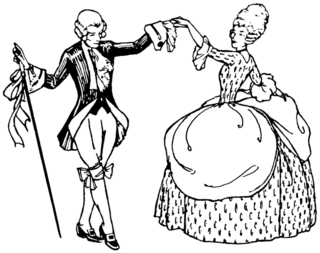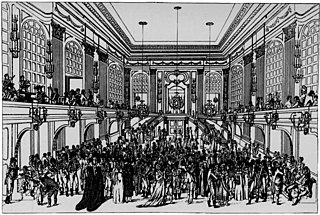
A minuet is a social dance of French origin for two people, usually in 3
4 time. The English word was adapted from the Italian minuetto and the French menuet.

Aleatoricmusic is music in which some element of the composition is left to chance, and/or some primary element of a composed work's realization is left to the determination of its performer(s). The term is most often associated with procedures in which the chance element involves a relatively limited number of possibilities.
Aleatoricism or aleatorism, the noun associated with the adjectival aleatory and aleatoric, is a term popularised by the musical composer Pierre Boulez, but also Witold Lutosławski and Franco Evangelisti, for compositions resulting from "actions made by chance", with its etymology deriving from alea, Latin for "dice". It now applies more broadly to art created as a result of such a chance-determined process. The term was first used "in the context of electro-acoustics and information theory" to describe "a course of sound events that is determined in its framework and flexible in detail", by Belgian-German physicist, acoustician, and information theorist Werner Meyer-Eppler. In practical application, in compositions by Mozart and Kirnberger, for instance, the order of the measures of a musical piece were left to be determined by throwing dice, and in performances of music by Pousseur, musicians threw dice "for sheets of music and cues". However, more generally in musical contexts, the term has had varying meanings as it was applied by various composers, and so a single, clear definition for aleatory music is defied. Aleatory should not be confused with either indeterminacy, or improvisation.

Johann Christoph Friedrich Bach was a German composer and harpsichordist, the fifth son of Johann Sebastian Bach, sometimes referred to as the "Bückeburg Bach".

Eine kleine Nachtmusik, K. 525, is a 1787 composition for a chamber ensemble by Wolfgang Amadeus Mozart (1756–1791). The German title means "a little night music". The work is written for an ensemble of two violins, viola, cello and double bass, but is often performed by string orchestras. The serenade is one of Mozart's most famous works.

The title Notebook for Anna Magdalena Bach refers to either of two manuscript notebooks that the German Baroque composer Johann Sebastian Bach presented to his second wife, Anna Magdalena. Keyboard music makes up most of both notebooks, and a few pieces for voice are included.

The Fantasy on Themes from Mozart's Figaro and Don Giovanni, S.697, is an operatic paraphrase for solo piano by Franz Liszt, based on themes from two different Mozart's operas: The Marriage of Figaro, K.492 and Don Giovanni, K.527.

The Kegelstatt Trio, K. 498, is a piano trio for clarinet, viola and piano in E-flat major by Wolfgang Amadeus Mozart.
Potpourri or Pot-Pourri is a kind of musical form structured as ABCDEF..., the same as medley or, sometimes, fantasia. It is often used in light, easy-going and popular types of music.

Friedrich Wilhelm Marpurg was a German music critic, music theorist and composer. He was friendly and active with many figures of the Enlightenment of the 18th century.

The composer Wolfgang Amadeus Mozart wrote a great deal of dance music, both for public use and as elements of larger works such as operas, quartets, and symphonies. According to the reminiscences of those who knew him, the composer himself enjoyed dancing very much; he was skillful and danced often.

Gottfried Wilhelm Fink was a German composer, music theorist, poet, and a Protestant clergyman.

Baron Henri Eduard Joseph de Lannoy, was a Flemish composer, teacher, conductor, and writer on music who spent most of his life in Austria. His compositions bridge the classical and early romantic styles. His full name and title in German was 'Heinrich Eduard Josef, Freiherr von Lannoy'.

The organ sonatas, BWV 525–530 by Johann Sebastian Bach are a collection of six sonatas in trio sonata form. Each of the sonatas has three movements, with three independent parts in the two manuals and obbligato pedal. The collection was put together in Leipzig in the late 1720s and contained reworkings of prior compositions by Bach from earlier cantatas, organ works and chamber music as well as some newly composed movements. The sixth sonata, BWV 530, is the only one for which all three movements were specially composed for the collection. When played on an organ, the second manual part is often played an octave lower on the keyboard with appropriate registration. Commentators have suggested that the collection might partly have been intended for private study to perfect organ technique, some pointing out that its compass allows it to be played on a pedal clavichord. The collection of sonatas is generally regarded as one of Bach's masterpieces for organ. The sonatas are also considered to be amongst his most difficult compositions for the instrument.
W. E. Scholz was a German composer and Kapellmeister / conductor at the court of Prince August zu Hohenlohe-Öhringen in Schlawentzitz in Upper Silesia.
Friedrich Wilhelm Birnstiel was an 18th-century German music publisher known for publishing two volumes of four-part chorales by Johann Sebastian Bach in the 1760s.
Heinrich Christoph Koch was a German music theorist, musical lexicographer and composer. In his lifetime, his music dictionary was widely distributed in Germany and Denmark; today his theory of form and syntax is used to analyse music of the 18th and 19th centuries.












